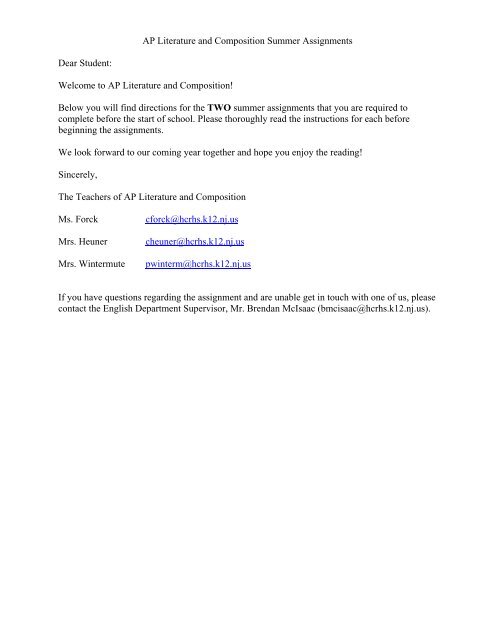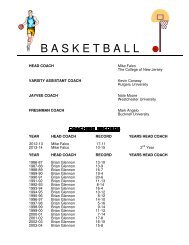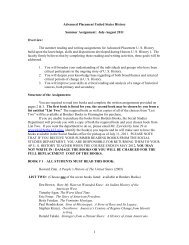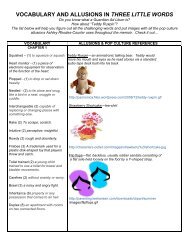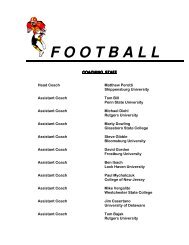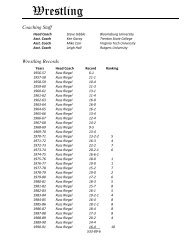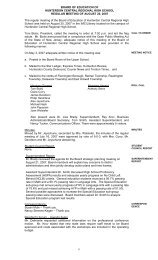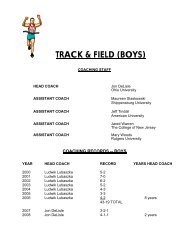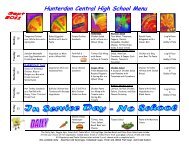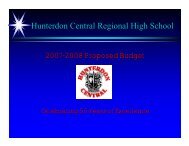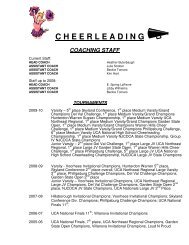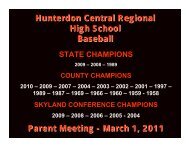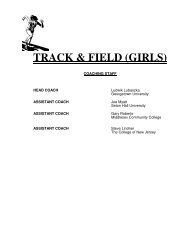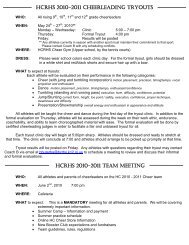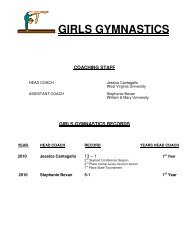AP Literature and Composition! - Hunterdon Central Regional High ...
AP Literature and Composition! - Hunterdon Central Regional High ...
AP Literature and Composition! - Hunterdon Central Regional High ...
Create successful ePaper yourself
Turn your PDF publications into a flip-book with our unique Google optimized e-Paper software.
<strong>AP</strong> <strong>Literature</strong> <strong>and</strong> <strong>Composition</strong> Summer AssignmentsDear Student:Welcome to <strong>AP</strong> <strong>Literature</strong> <strong>and</strong> <strong>Composition</strong>!Below you will find directions for the TWO summer assignments that you are required tocomplete before the start of school. Please thoroughly read the instructions for each beforebeginning the assignments.We look forward to our coming year together <strong>and</strong> hope you enjoy the reading!Sincerely,The Teachers of <strong>AP</strong> <strong>Literature</strong> <strong>and</strong> <strong>Composition</strong>Ms. ForckMrs. HeunerMrs. Wintermutecforck@hcrhs.k12.nj.uscheuner@hcrhs.k12.nj.uspwinterm@hcrhs.k12.nj.usIf you have questions regarding the assignment <strong>and</strong> are unable get in touch with one of us, pleasecontact the English Department Supervisor, Mr. Brendan McIsaac (bmcisaac@hcrhs.k12.nj.us).
Assignment #1 (20 points)Choose a work from the list below, read it, <strong>and</strong> take careful notes on the topics as describedbelow.Crime <strong>and</strong> PunishmentTess of the D’urbervillesLight in AugustSong of SolomonPurchase any edition of the above text that you select. If you cannot purchase the novel, copiesare available for you in the supervisor’s office near room 810. We encourage you to purchaseyour own text because you can write in it.* Please see the note on plagiarism <strong>and</strong> academic integrity at the end of this document!What to Include:Your notes are like a skeleton of a writing you might do. This means that they should includeaspects of the novel you would mention in an essay. Consider how the following categoriesdevelop the overall themes in the text: Characterization Setting (insofar as it impacts theme <strong>and</strong> character) Tone (the author’s attitude toward the subject matter) Stylistic elements: the author’s use of dialogue, diction (word choice), figurativelanguage (simile, metaphor, imagery, symbol)When referencing the above categories, make sure you’re connecting them to the overall themesyou’re identifying in your notes. Trace a theme throughout the text <strong>and</strong> comment on itsdevelopment. It is important to include not only information the author says, but also yourthoughts, analysis, <strong>and</strong> evaluation of that information. You are expected to take notes on theENTIRE TEXT. Notes that cease well before the end of the novel, or only include 1-2comments for hundred page sections, will be penalized accordingly.What to Avoid:Students often make the mistake of writing their notes as a catalog of events. Try to avoidentries that have no relationship to each other. Avoid taking too many notes from the beginningof the novel, as this means that you will not have enough space to include the latter part of thenovel. Notes that are not as successful tend to use the same kind of commentary over <strong>and</strong> over;they may refer to the same characters repeatedly, or ask questions about the upcoming events inthe text, but offer little analysis of the text. Poor notes catalogue events from the text withoutcommenting on them or explaining their significance in relation to other parts of the text. Poornotes don’t take the entire novel into consideration, but refer to specific parts, overlooking oreliminating others.
Organization:It is best to read the novel as a whole, putting in h<strong>and</strong>written or other notes, <strong>and</strong> then go back <strong>and</strong>take detailed notes. You need to take notes from the beginning, middle, <strong>and</strong> end of the novel.PACE yourselves.Examples of successful notes (commentary on each note is bolded <strong>and</strong> in parentheses):15 (page number) Everyone in the city is breaking down—even good wife Katherine Ivanovna“breaks out” <strong>and</strong> makes stepdaughter suffer (This note makes a general statement about othercharacters in relation to a main character)16 Sonia’s “body <strong>and</strong> shoulders kept trembling”; she was traumatized probably for the rest of herlife because of her childhood… does Dostoyevsky think childhood determines the future? (Here,she connects Sonia’s experience to one of D’s possible themes; then, explore this theme asyou continue reading).292-293 Here we learn more about Peter. He uses sarcasm when his is addressing Dunia: “I amleaving, madame—but…” Because it is italicized I get the feeling that he doesn’t actually meanit <strong>and</strong> said it with an attitude. On the next page, the first paragraph tells of his character. Itportrays him as very vain <strong>and</strong> only loves himself <strong>and</strong> his money. He never really cared aboutDunia. The most important person to him is himself. (She analyzes D’s use of language <strong>and</strong>what it suggests about Luzhin’s character).475 Water has a negative connotation: “The water did not fall in drops, but lashed the earth intorrents.” This occurs during a shift to Svidrigailov. In relation to him, he is not cleansed by therain, but tormented by its rage against him <strong>and</strong> his deceiving, blackmailing wishes withRaskolnikov <strong>and</strong> Dunia (This is an analysis of D’s use of symbol <strong>and</strong> connects it toSvidrigailov).In summation, with each note you take, make sure that it offers your analysis of the informationor quotations you cite. We are looking for evidence of your thinking about the text, not asummary of what you read in the text. We are looking for evidence of your ability to noticethematic str<strong>and</strong>s they relate to specific elements of the text (character development, setting, <strong>and</strong>others listed above).LENGTH: 6-7 pages if typed (see guidelines below), 8-10 sides of a page if h<strong>and</strong>written.If you type your response, single-space your commentary <strong>and</strong> double-space between entries (asshown in the sample above). If you h<strong>and</strong>write your notes, write them in PEN. Make them aslegible as possible; if your h<strong>and</strong>writing is hard to read, then type your notes. The front <strong>and</strong> backof a page = TWO pages of notes (not one). If your h<strong>and</strong>writing is very large, make adjustmentsto your notes accordingly. Avoid quoting long blocks of text; if you do this, your analysis of thequote you cite must be twice as long as the quote itself. Your job is to notice the details of thelanguage in the text. Don’t let the quotes you select speak for you. You speak about them!
Assignment #2 (25 points)Select one of the works from the list below <strong>and</strong> complete the following assignment.Explain how the author uses a specific literary device or element (ex: character development,symbol, point of view, plot structure, setting) to illustrate a specific theme or idea the authordevelops throughout the novel. When coming up with a thesis statement, do not summarize thenovel. For example, the thesis statement “In Heart of Darkness, Joseph Conrad usescharacterization to reveal a theme of transformation throughout the novel” is too broadbecause it does not mention how Conrad comments on transformation. An improved thesisreads: “Conrad’s characterization reveals the idea that environment transforms the individualphysically, intellectually <strong>and</strong> psychologically, while intensifying certain innate traits.” Thisthesis statement shows Conrad’s attitude toward transformation <strong>and</strong> how it is presented in thenovel.Length requirement: 600 words (no longer).Please double space <strong>and</strong> use a 12 point Times New Roman font size. Be sure to include textualsupport (direct quotations) in defense of your argument.This analysis is due on the first day of class.* Please see the note on plagiarism <strong>and</strong> academic integrity at the end of this document!A few words on theme statements:A good theme statement is an assertion (yours) of what you feel to be the author’s mainargument (philosophical, moral, world-view, etc.) in the work. If your paper had to be reduced to asingle sentence, it should be your theme statement. Many students have a tendency to arrive at their truetheme statement when composing the conclusion. This is generally the result of not having a clear themebefore writing <strong>and</strong> allowing one to emerge through the writing. While this approach may be a wonderfuljourney of discovery for the writer, who finally arrives at what he or she thinks about the piece, it isgenerally disconcerting for the reader who is trying to find a main idea to follow.“Material wealth is a theme in The Great Gatsby.”The above is not an appropriate statement of theme. It says nothing.“The Buchanans illustrate the evil influences of wealth.”This also is not an appropriate statement of theme.“Material wealth corrupts the rich <strong>and</strong> destroys the poor.”Now, this is an appropriate statement of theme. WHY?It is in the form of a complete declarative sentence.It expresses an opinion.It is written in a general format without specific references to characters or situations in thenovel.
* Note Regarding Academic Integrity <strong>and</strong> PlagiarismIt is our expectation that you will not use outside sources, such as study guides (Internet orotherwise), to aid you in producing your summer assignments. However, if you do chooseto visit such sources for help or to affirm your own thinking it is absolutely imperative thatyou properly document any sequence of ideas or direct quotations that you may take fromthem. Failure to do so is an act of plagiarism <strong>and</strong> a violation of <strong>Hunterdon</strong> <strong>Central</strong>’sacademic integrity policy. This violation will result in a permanent zero on the assignment!LITERARY WORKSThe Reader’s Notebook is due on the firstday of classTolstoy - Anna Karenna, War <strong>and</strong> PeaceMelville - Moby DickDickens - David Copperfield, GreatExpectationsR<strong>and</strong> - The FountainheadHomer - The IliadDostoyevsky - The Brothers KaramazovAndrews - Tom JonesJoyce - Ulysses, Portrait of the Artist as aYoung Man, DublinersDreiser - An American TragedyHeller - Catch 22Turgenev - Fathers <strong>and</strong> SonsWarren - All the King’s MenDafoe - Moll Fl<strong>and</strong>ersMaughm - Of Human BondageFitzgerald - Tender is the NightAchebe - Things Fall ApartCather - My AntoniaSteinbeck - East of Eden, The Grapes ofWrathLawrence - Sons & LoversHemingway - Farewell to ArmsWright - Native Son (the book –not the play)Morrison - BelovedWharton - Age of InnocenceCervantes - Don QuixoteSilko - CeremonyAusten - EmmaDanticat - Breath, Eyes, MemoryAeschylus – Oresteia(all three plays)Hardy - Jude the ObscureWoolf - To the LighthouseIshiguro - The Remains of the DayKafka - The TrialConrad - Heart of DarknessHong-Kingston - Woman WarriorMarquez - One Hundred Years of SolitudeFlaubert - Madame BovaryEllison - Invisible ManForester - A Passage to India
Assignment #1 Notebooks will be assessed using the following rubric:“A” Range • Deep <strong>and</strong> broad underst<strong>and</strong>ing of the entire work• Analysis is mature, specific <strong>and</strong> original• Insight that recognizes <strong>and</strong> appreciates what most students miss• <strong>Composition</strong> reflects exemplary comm<strong>and</strong> of language, style <strong>and</strong>usage• Ample <strong>and</strong> revealing textual evidence• Categories demonstrate appropriately balanced development“B” Range • Adequate underst<strong>and</strong>ing of the work <strong>and</strong> its complexities• Analysis is specific but limited or inexact in total scope• Insight that recognizes what some students miss• <strong>Composition</strong> reflects strong comm<strong>and</strong> of language, style <strong>and</strong> usage,but may be uneven throughout• Adequate <strong>and</strong> obvious textual support• Categories demonstrate some imbalance in development <strong>and</strong> depth“C” Range • Superficial <strong>and</strong> general underst<strong>and</strong>ing of the work as a whole• Analysis is limited, inexact <strong>and</strong> vague, tending toward summary• Insight that recognizes easily identifiable points with littleelaboration• <strong>Composition</strong> reveals errors in basic comm<strong>and</strong> of language, style<strong>and</strong> usage• General references to the text with little direct quotation, orirrelevant references• Categories are limited <strong>and</strong>/or imbalanced in development <strong>and</strong> depth“D” Range • Little or partial underst<strong>and</strong>ing of the work as a whole• Summary with scant analysis• Vague insight relying on generalizations• <strong>Composition</strong> reveals glaring <strong>and</strong> repeated errors that distract thereader• General references to the text with little direct quotation, orirrelevant references• Categories are limited <strong>and</strong>/or imbalanced in development <strong>and</strong>depth. One or more categories may be missing“F” Range • Clear indication that the work was only partially read or not read atall• Cursory summary• Vague <strong>and</strong> incomprehensible commentary• <strong>Composition</strong> reveals glaring <strong>and</strong> repeated errors that make meaningunintelligible• Vague reference to the text with no direct quotation• Categories are severely underdeveloped. One or more categories ismissing.
Assignment #2 essays will be assessed using the following rubric:Holistic Grade Organization Focus Development Grammar/Style/MechanicsA-(94), A(96),A+ (100)B-(86), B (88),B+ (92)C-(76), C(80),C+ (84)D(70), D (72)D+ (75)* Clear thesis stated inthe introduction* Transitions are clear<strong>and</strong> make the paperflow* Quotations arecontextualized* Literary TQ identified<strong>and</strong> thoroughlydiscussed.* Clear thesis stated inthe intro; may beunclear in places* Some transitionsneeded; transitions maybe repetitive oroverused.* Quotations arecontextualized* Literary TQ identified<strong>and</strong> discussedsomewhat thoroughly.* Thesis is somewhatclear, but ideas seemjumbled <strong>and</strong>unorganized.* Several transitionsneeded.* Some quotations arenot introduced properly* Literary TQ may beidentified by isdiscussed infrequentlyin the essay.* Unclearproject/purpose* Several transitionsneeded.* Quotations are notproperly contextualized.* Literary TQ is notidentified or is notdiscussed at all in theessay.*Established in theintro, maintained ineach body paragraph,<strong>and</strong> is emphasized inthe conclusion.*Topic sentences havea direct connection tothe thesis statement.* Clear focus in theintro, but could beclearer throughout theessay. ORUnclear focus in theintro but the focusbecomes clarified as theessay continues.*Most topic sentenceshave a directconnection to the thesisstatement.* Focus is generallyclear, but the focus isnot maintainedthroughout the essay.Subtopics may detractfrom the essay’s mainfocus.* Few topic sentenceshave a direct connectionto the thesis statement.* Unclear focusthroughout the essay.* Topic sentences arenot connected to thethesis statement or aremissing entirely.* Body Paragraphs build onone another <strong>and</strong> do not repeatthe same information.* Specific details enhance thewriting.* Quotations support the thesis,are integrated <strong>and</strong> analyzed indetail.* Analysis throughoutexplicates the theme stated inthe thesis.* Some repetition in bodyparagraphs* Most details are specific(some may be general)* Most quotes support or relateto the thesis. Some quotescould better support the thesisor could be incorporated <strong>and</strong>analyzed more effectively.* Analysis in places explicatesthe theme stated in the thesis.* Frequent repetition of ideasthroughout the essay* Details are general (notspecific)* Some quotes do not relate tothe thesis. Quotes are notincorporated or analyzedeffectively.* Analysis is present, but issuperficial <strong>and</strong> does notexplicate the theme.* Frequent repetition of ideasthroughout the essay* Details are general or aremissing entirely* Most quotes do not clearlysupport the thesis.* Analysis is absent or off topic.*Few spelling,grammatical,mechanicalerrors.*Clear syntax*Quotations arecited properly<strong>and</strong> formattedcorrectly.* Few spelling,grammatical,mechanicalerrors.* Mostly clearsyntax.* Quotations arecited properly<strong>and</strong> formattedcorrectly.* Severalspelling,grammatical,mechanicalerrors.* Unclearsyntax* Severalquotations arenot citedproperly orformattedcorrectly.* Numerousspelling,grammatical,mechanicalerrors.* Unclearsyntax.* Severalquotations arenot citedproperly orformattedcorrectly.F (69 or below)* Unclear thesis* Many transitionsneeded* No quotes present orquotes may be usedincorrectly.* Literary TQ notmentioned.* Unclear focusthroughout the essay.* Topic sentences aremissing or unrelated.* The essay lacks anynew ideas; details aremissing entirely.* Quotes are missing ordo not support the thesisat all.* Analysis is absent.* Numerous spelling,grammatical,mechanical errors.* Unclear syntax.* Several quotations arenot cited properly orformatted correctly.


